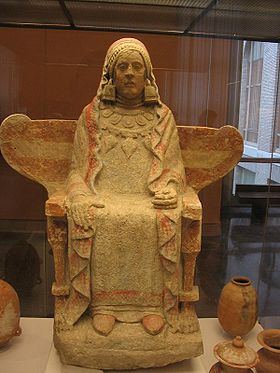
Lady of Baza
Encyclopedia

Iberian sculpture
Iberian sculpture, a subset of Iberian art, describes the various sculptural styles developed by the Iberians from the Bronze age up to the Roman conquest...
by the Bastetani
Bastetani
The Bastetani or Bastuli were an ancient Iberian people of the Iberian peninsula . They are believed to have spoken the Iberian language....
. It is a limestone
Limestone
Limestone is a sedimentary rock composed largely of the minerals calcite and aragonite, which are different crystal forms of calcium carbonate . Many limestones are composed from skeletal fragments of marine organisms such as coral or foraminifera....
female figure with traces of painted detail in a stuccoed surface that was found on July 22, 1971 by Francisco José Presedo Velo, at Baza
Baza, Granada
Baza is a town in the province of Granada in southern Spain. It has 21,000 inhabitants . It is situated at 844 m above sea level, in the Hoya de Baza, a valley of the Sierra Nevada, not far from the Gallego River. This town gives its name to the Sierra de Baza...
, in the altiplano, the high tableland in the northwest of the province of Granada
Granada (province)
Granada is a province of southern Spain, in the eastern part of the autonomous community of Andalusia. It is bordered by the provinces of Albacete, Murcia, Almería, Jaén, Córdoba, Málaga, and the Mediterranean Sea . Its capital city is also called Granada.The province covers an area of 12,635 km²...
. The town of Baza was the site of the Ibero-Roman city of Basti and, in one of its two necropoleis, the Cerro del Santuario, the Lady of Baza was recovered. She is seated in an armchair, and an open space on the side is thought to have contained ashes from a cremation
Cremation
Cremation is the process of reducing bodies to basic chemical compounds such as gasses and bone fragments. This is accomplished through high-temperature burning, vaporization and oxidation....
.
The sculpture's name links it in the popular imagination to its more famous cousin, the Lady of Elche. After conservation, the sculpture, which dates to the fourth century BCE, joined the enigmatic Lady of Elche deposited in the National Archaeological Museum of Spain
National Archaeological Museum of Spain
The National Archaeological Museum of Spain is a museum in Madrid, Spain, located beside the Plaza de Colón , sharing its building with the National Library....
in Madrid
Madrid
Madrid is the capital and largest city of Spain. The population of the city is roughly 3.3 million and the entire population of the Madrid metropolitan area is calculated to be 6.271 million. It is the third largest city in the European Union, after London and Berlin, and its metropolitan...
. The chimera
Chimera (mythology)
The Chimera or Chimaera was, according to Greek mythology, a monstrous fire-breathing female creature of Lycia in Asia Minor, composed of the parts of multiple animals: upon the body of a lioness with a tail that ended in a snake's head, the head of a goat arose on her back at the center of her...
Biche of Balazote
Biche of Balazote
The so-called Bicha of Balazote is an Iberian sculpture that was found in the borough of Balazote in Albacete province , Spain. It was first studied by a group of French archaeologists who identified it as a kind of deer, hence the name 'biche' , which was then Castillianized to 'bicha', i.e.,...
and the standing Gran Dama Oferente, also called Dama del Cerro de los Santos are exhibited in the same room of the museum.
External links
- Illustration of the Lady of Baza
- Article at Enciclopedia LibreEnciclopedia LibreEnciclopedia Libre Universal en Español is a Spanish language wiki encyclopedia, released under the Creative Commons Attribution-ShareAlike License. It uses the MediaWiki software. It started as a fork of the Spanish Wikipedia.-History:...

